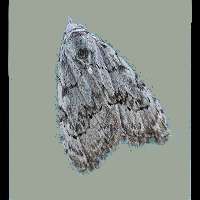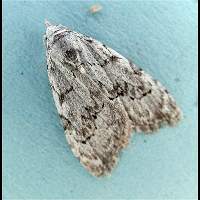Least Black Arches Nola confusalis
Of the Black Arches this is one of the most common species in Britain. The markings are rather vague, but usually it is quite unmistakable, for it is the first of the Black Arches to appear. It is however similar to the Small Black Arches. That species makes the impresiion of being larger, because the wings are broader. The forwings are slightly darker than the forwings of Least Black Arches. The main difference is in the hindwings, which are much darker than those of Least Black Arches. And usually Least Black Arches stops flying about at the same time Small Black Arches starts flying. Least Black Arches is a rather unimpressive species, because the wingspan is some 16 to 24mm only.
The first eggs will hatch in June. The caterpillars grow very fast indeed. In August they are fully grown. They then spin a firm, rather rounded cocoon which is attached to the bark of trees. The caterpillars immediately pupate and spend the winter that way. The caterpillars are very similar to those of the Footmen, but have one pair of false legs less. They are light brown in colour and the body has a number of small orange warts on side and back in which stiff white hairs are inplanted. There are two, dark and regularly interrupted dorsal lines. Between the lines a variable number of darkbrown often triangular markings. The head is orange. The larvae can be found on a number of trees and shrubs, especially oak, beech and apple. They eat the leaves of the foodplant and not the lichens growing on the foodplant believed to be the food in the past. The caterpillars are rather fat, but reaching a length of 14mm remain rather short.
Least Black Arches is on the wing in May and June. It flies by night only, but is attracted to light. May also been seen during the day resting on tree trunks. This is a common species to befound all over Wales and Southern England, especially on rocky and sandy soil. A local species in Western Scotland and Northern England and Ireland. Scarce in northern Scotland. Also a local species on most parts of the continent, but becoming more numerous towards the south.
Of the Black Arches this is one of the most common species in Britain. The markings are rather vague, but usually it is quite unmistakable, for it is the first of the Black Arches to appear. It is however similar to the Small Black Arches. That species makes the impresiion of being larger, because the wings are broader. The forwings are slightly darker than the forwings of Least Black Arches. The main difference is in the hindwings, which are much darker than those of Least Black Arches. And usually Least Black Arches stops flying about at the same time Small Black Arches starts flying. Least Black Arches is a rather unimpressive species, because the wingspan is some 16 to 24mm only.
The first eggs will hatch in June. The caterpillars grow very fast indeed. In August they are fully grown. They then spin a firm, rather rounded cocoon which is attached to the bark of trees. The caterpillars immediately pupate and spend the winter that way. The caterpillars are very similar to those of the Footmen, but have one pair of false legs less. They are light brown in colour and the body has a number of small orange warts on side and back in which stiff white hairs are inplanted. There are two, dark and regularly interrupted dorsal lines. Between the lines a variable number of darkbrown often triangular markings. The head is orange. The larvae can be found on a number of trees and shrubs, especially oak, beech and apple. They eat the leaves of the foodplant and not the lichens growing on the foodplant believed to be the food in the past. The caterpillars are rather fat, but reaching a length of 14mm remain rather short.
Least Black Arches is on the wing in May and June. It flies by night only, but is attracted to light. May also been seen during the day resting on tree trunks. This is a common species to befound all over Wales and Southern England, especially on rocky and sandy soil. A local species in Western Scotland and Northern England and Ireland. Scarce in northern Scotland. Also a local species on most parts of the continent, but becoming more numerous towards the south.





